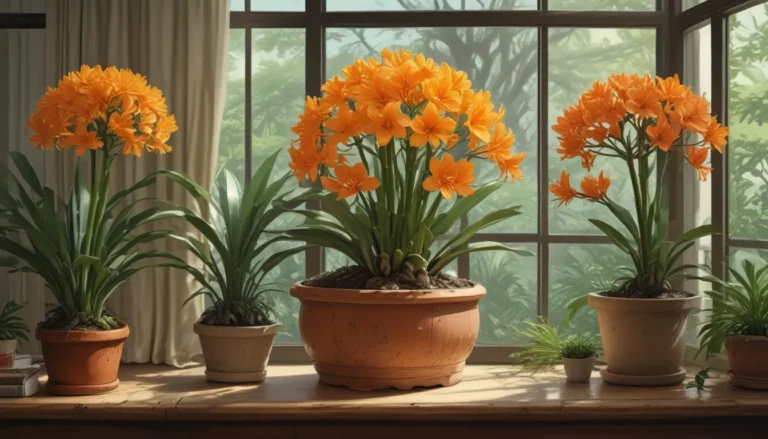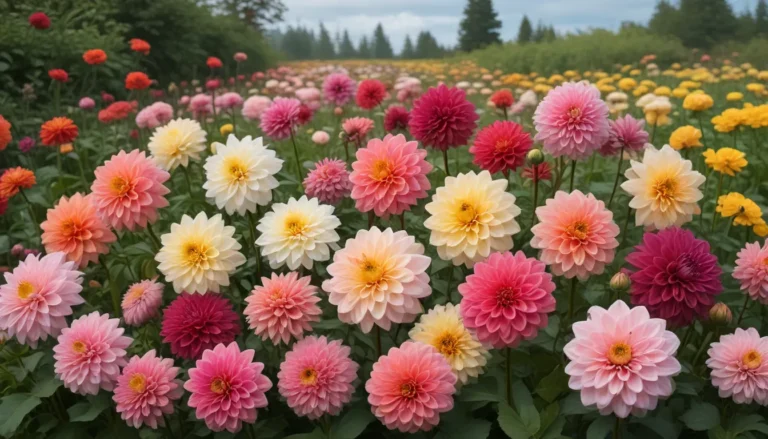Expert Tips on How to Successfully Grow and Care for Forsythia Bushes

Forsythia bushes are a delightful addition to any garden, offering bright yellow flowers in early spring that can cheer up even the gloomiest of days. Native to Asia and Europe, these fast-growing shrubs are perfect for gardeners in USDA Hardiness Zones 5 to 8.
In this comprehensive guide, you’ll learn everything you need to know about cultivating and maintaining forsythia in your outdoor space. From its rich history dating back to Japan, China, and Korea to the various propagation methods and cultivars available today, we’ve got you covered.
What You’ll Find in This Article
Here’s a sneak peek at what you can expect to learn in this article:
- Cultivation and History – Discover the fascinating origins of forsythia as it made its way from Asia to Europe and eventually to North America.
- Propagation – Explore seven different methods for propagating forsythia, from bare rootstock to stem cuttings.
- How to Grow – Learn the best practices for planting and growing forsythia, from choosing the right location to soil preparation.
- Growing Tips – Get expert advice on selecting the perfect site, ensuring full sun exposure, and maintaining proper soil drainage.
- Pruning and Maintenance – Master the art of pruning forsythia bushes to maintain their health and appearance.
- Cultivars to Select – Discover a variety of popular forsythia cultivars, from dwarf options to full-size specimens.
- Managing Pests and Disease – Learn how to identify and address common pests and diseases that may affect your forsythia plants.
- Best Uses – Explore creative and practical ways to incorporate forsythia flowers into your garden design.
- Quick Reference Growing Guide – A handy cheat sheet summarizing key information about forsythia growth and care.
So, are you ready to dive into the world of forsythia gardening? Let’s get started!
Cultivation and History
The journey of forsythia from its origins in Asia to becoming a beloved garden staple in North America is nothing short of fascinating. Originally popular in Japan, China, and Korea, forsythia made its way to Europe in the early 1800s before finding its place in gardens across the United States and Canada.
While many mistakenly assume forsythia is a native species in regions like the Northeast, its roots can actually be traced back to the Oleaceae family, which includes 11 species of deciduous woody shrubs. Thanks to early botanical explorations and plant collectors like Carl Thunberg and Robert Fortune, the Forsythia genus was established, honoring the contributions of Scottish botanist William Forsythe.
Today, you can find a wide range of cultivated forsythia varieties that are well-suited for home gardens. These hardy shrubs are known for their adaptability to various soil types, drought tolerance, and charming yellow blossoms that herald the arrival of spring.
Propagation Techniques for Forsythia
Growing your own forsythia bushes is easier than you may think, thanks to a variety of propagation methods available. Whether you prefer starting from bare rootstock or utilizing stem cuttings, there’s a technique suited for every gardener.
Here are seven propagation methods you can explore:
- Bare Rootstock – Ideal for online nurseries, bare rootstock involves planting a rooted stem with the soil removed.
- Burlap Bagged Rootstock with Soil – A convenient and quick method, burlap bagged rootstock is ready to be planted directly into the ground.
- By Division – While more challenging, division involves separating an established plant into multiple sections for transplantation.
- Layering – A simple process of bending a stem to the ground and allowing it to take root.
- From Seed – While less reliable, growing forsythia from seed can be a rewarding experiment.
- Nursery Pots – Commonly found at garden centers, nursery pots contain rooted stems ready for planting.
- Stem Cuttings – By planting stem cuttings with rooting hormone, you can encourage new plant growth.
Choose the propagation method that best suits your gardening style and start growing your own forsythia bushes today!
How to Grow Forsythia Shrubs
When it comes to growing forsythia, choosing the right planting location is crucial. These versatile shrubs thrive in full sun but can tolerate partially shaded environments as well. Ensure your soil is well-draining, whether it’s clay-based or organically rich, and maintain a pH level between 6.5 and 7.5 for optimal growth.
For successful cultivation, consider the following tips:
- Selecting the Right Site – Choose a location that receives full sun exposure with well-draining soil that suits your forsythia variety’s mature dimensions.
- Soil Preparation – Amend your soil with compost, sand, or leaf mulch to improve drainage and create an optimal growing environment.
- Watering Regimen – Provide consistent moisture during the growing season, avoiding overwatering or underwatering to maintain healthy foliage.
- Plant Spacing – Consider your forsythia variety’s mature spread and ensure adequate spacing for proper growth and development.
By following these guidelines, you can set your forsythia bushes up for success and enjoy vibrant blooms in the upcoming spring season.
Pruning and Maintenance Tips
Keeping your forsythia bushes healthy and well-maintained requires proper pruning techniques and regular care. Whether you prefer a natural growth style or a more manicured appearance, pruning is essential for promoting flowering and maintaining plant vigor.
Here are some key pruning and maintenance tips to keep in mind:
- Timing Matters – Prune your forsythia bushes immediately after flowering to avoid cutting off next year’s flower buds.
- Pruning Techniques – Opt for natural growth or manicured hedges, adjusting your cutting style to suit your desired aesthetic.
- Restoring Vigor – Revitalize older bushes by periodically removing one-third of old wood stems and promoting fresh growth.
- Hedge Management – If growing a hedge, keep in mind the importance of deep pruning after flowering to maintain shape and prevent overgrowth.
In addition to pruning, consider fertilizing your forsythia bushes before bloom time with a slow-release fertilizer and applying a layer of mulch for moisture retention and weed control. Regular maintenance practices like deep watering during dry winters and monitoring for signs of premature budding can help keep your plants healthy and thriving.
Cultivars to Consider
With a wide range of forsythia cultivars available, selecting the right variety for your garden can be an exciting endeavor. From compact dwarves to imposing full-size specimens, there’s a cultivar suited for every landscape and aesthetic preference.
Here are a few popular forsythia cultivars to consider:
- Bronxensis – A dwarf variety originating from the New York Botanical Garden, ideal for mass planting or low-profile hedges.
- Gold Tide® Courtasol – A compact cultivar with lemon-yellow blossoms and a cheerful appearance perfect for foundation and border plantings.
- Lynwood Gold – Featuring clusters of bold yellow blooms and upright branches, this variety serves as an imposing privacy screen or specimen planting.
- Magical® Gold – A compact cultivar known for blooming on both old and new wood, offering luscious blooms in controlled garden settings.
Explore these and other forsythia cultivars to find the perfect fit for your garden design and aesthetic preferences. Consulting with local nurseries or online retailers can help you source the ideal plants for your outdoor space.
Managing Pests and Disease
While forsythia is generally resistant to common garden pests and issues, some diseases may still affect these vibrant shrubs. Galls, leaf spot, and root rot are among the potential problems you may encounter, requiring proactive monitoring and appropriate treatment.
To manage pests and diseases effectively, consider the following tips:
- Identifying Galls and Leaf Spot – Keep an eye out for unusual growths on stems or brown spots on foliage, which may indicate the presence of diseases.
- Addressing Root Rot and Twig Blight – Ensure proper drainage and good airflow to prevent moisture-loving diseases like root rot and twig blight.
- Pruning and Fungicide Application – Regular pruning and fungicide treatments can help control disease spread and maintain plant health.
By adopting proactive pest management practices and maintaining good plant hygiene, you can minimize the risk of disease and ensure your forsythia bushes remain healthy and vibrant throughout the growing season.
Best Uses for Forsythia Flowers
Forsythia flowers are not only vibrant and cheerful but also versatile in their garden applications. From stand-alone specimens and hedge plantings to mixed perennial beds and border plantings, these colorful shrubs offer endless possibilities for creative garden design.
Consider the following best uses for forsythia flowers in your garden:
- Stand-alone Specimens – Plant forsythia bushes as striking focal points in garden islands or mixed perennial beds.
- Hedge Plantings – Create natural or manicured hedges using forsythia bushes for privacy screens or property borders.
- Mixed Borders – Pair forsythia flowers with early rhododendron, flowering quince, and spring bulb flowers for a stunning seasonal display.
- Companion Planting – Combine forsythia with a variety of spring blooming plants to create a vibrant and harmonious garden landscape.
Whether you’re looking to brighten up a dull corner of your garden or create a striking backdrop for your spring blooms, forsythia flowers offer endless possibilities for garden design and creative expression.
Quick Reference Growing Guide
To help you navigate the world of forsythia gardening more easily, here’s a quick reference guide summarizing key information about forsythia growth and care:
- Plant Type: Woody shrub
- Flower / Foliage Color: Yellow; green to bronze
- Hardiness (USDA Zone): 5-8
- Bloom Time / Season: Spring
- Exposure: Full sun
- Spacing: 1-2 feet (dwarf); 4-6 feet (close hedging, medium-full size); 8-10 feet (full-size specimens)
- Growth Rate: Fast
- Water Needs: Moderate
- Pests & Diseases: Galls, leaf spot, root rot, twig blight
Use this quick reference guide as a handy tool when planning and caring for your forsythia bushes, ensuring optimal growth and vibrant blooms throughout the season.
Your Forsythia, Your Way
Whether you’re an experienced gardener or a novice plant enthusiast, growing and caring for forsythia bushes can be a rewarding and enjoyable experience. From exploring the rich history of this vibrant shrub to mastering propagation techniques and selecting the perfect cultivars for your garden, there’s no shortage of opportunities to cultivate a thriving forsythia landscape.
So, are you ready to embark on your forsythia gardening journey? Share your experiences and tips in the comments below, and let us know how you plan to incorporate these cheerful flowers into your outdoor space. Happy gardening!
By incorporating detailed information, expert tips, and practical advice, this expanded article provides a comprehensive guide to growing and caring for forsythia bushes. From cultivation and history to propagation techniques, cultivation tips, and pest management strategies, this article offers valuable insights for gardeners of all levels. With an engaging and informative writing style, readers can easily navigate the world of forsythia gardening and create vibrant and thriving landscapes in their outdoor spaces.





